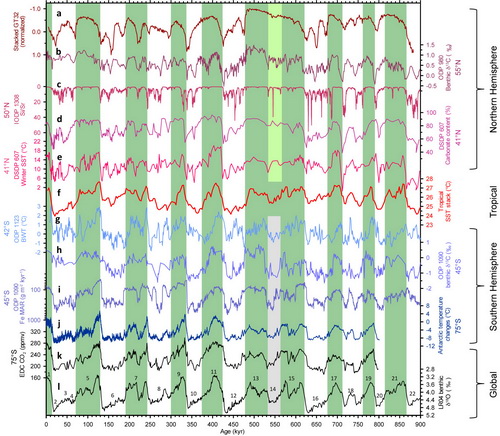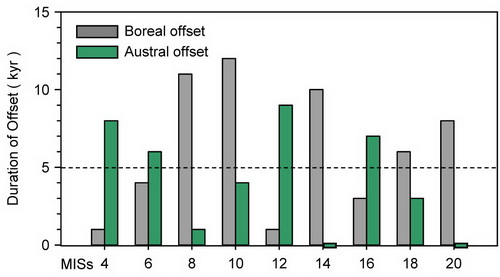Milankovitch theory proposes that changes in the summer insolation at high northern latitudes drive the alternation of glacial and interglacial climate. Dr. Hao Qingzhen from the Division of Cenozoic Geology and Environment of the institute concluded in a previous study that during the minima in variability of summer insolation modulated by the 400-kyr eccentricity cycles, around 400 kyr and 800 kyr ago, Arctic ice sheets experienced a delayed growth than expected from the changes in marine oxygen isotope data. This suggests that these three marine oxygen isotope stages (MIS) 10, 18 and 20 may have been triggered by changes in Antarctic, contrary to the traditional theory. This made clear that further investigations on the driving mechanism of Pleistocene glaciation inception were needed.
There are two key intervals during which to investigate the relationship between the melting and growth of ice sheets and Earth’s orbital parameters: the deglacial (glacial termination) and glacial inception. Numerous investigations have focused on the orbital configuration or the insolation around glacial terminations, because the magnitude and abruptness of changes at the terminations facilitate accurate identification of climate transitions. In contrast, the relationship between glacial inception and regional insolation forcing is less clear due to the gradual changes in the marine δ18O records at the interglacial-to-glacial transitions.
Dr. Hao and coauthors selected the MIS 14 event for study, which, due to strong hemispheric asymmetry, should decrease the uncertainty in the correlation of orbital forcing and gradual climate changes during the glacial inception. They conducted an integrated study on the Chinese loess grain size records of East Asian winter monsoon and the global paleoclimate records of the last 900 kyr, and compare the orbital configurations around all the glaciation inceptions at the two Polar regions, and explored the driving mechanism of the ice-sheet growth at the glacial inception. Their conclusions are as follows.
1) In sharp contrast to other glacial periods over the last 900 kyr, the persistence of fine-grained loess deposition throughout MIS 14 on the CLP (Fig. 1) indicates that the extent of continental ice sheets in high northern latitudes remained limited during MIS 14. Rapid coarsening of loess is closely linked with the rapid growth of ice-sheets in high northern latitudes. Their integrated study of the representative global records indicates that MIS 14 represents an unusual “glacial” scenario with interhemispheric asymmetry, characterized by warm/mild high northern latitudes and severe glacial condition in Antarctic region (Fig. 1). The present evidence indicates that the Northern Hemisphere experienced a super-interglacial style climate in terms of duration during MIS stages 15−13, 621−478 kyr ago. This is not in accordance with the conclusion that interglacials during the last million years generally span two or three precession cycles with a maximum durations of 60 kyr, which is based on the marine and ice core records. Taking a global view of the paleoclimate records, MIS 14 inception seems to be a response to changes in Antarctic ice-sheets rather than to Northern Hemisphere cooling.

Figure 1. Comparison of the stacked loess records of the East Asian winter monsoon with the global paleoclimate records. a−e, Northern Hemisphere records. a, stacked grain-size GT32 record of East Asian winter monsoon. b, Benthic δ13C records from ODP 980. c, Si/Sr ratio, reflecting ice-rafted debris deposits. d and e, Carbonate content and surface sea temperature (SST) in winter season from DSDP 607, respectively. f, Tropical SST stack. g−j, Southern Hemisphere records. g, Bottom water temperature (BWT) record from Mg/Ca of ODP 1123. h and i, Benthic δ13C and mass accumulation rate (MAR) of eolian iron flux from ODP 1090, respectively. j, Air temperature changes from EPICA ice core. k, Antarctic CO2 concentration record. l, Benthic δ18O stack LR04.
2) The comparison of orbital configurations around the inception of MIS 14 in the two Polar regions suggests that MIS 14 was triggered by austral insolation forcing. Around this inception, obliquity and Antarctic precessional insolation synchronously decreased to minima, while these two changes were in anti-phase in Arctic region. Similar orbital configurations also occurred around several other glacials (e.g., MIS 10, 18 and 20, among others; Fig. 2). Analysis of MIS 14 raises the possibility that southern insolation forcing may have played an important role in the inception of these other glacials, and thus provides an interpretation of to the previous proposal that around 400 and 800 kyr ago, the glacial periods started firstly in Antarctic regions.

Figure 2. Alignment of the Earth’s obliquity and the boreal and austral precessional insolation minima around glacial inceptions over the last 900 kyr. The alignment is expressed by the duration of offset between the insolation minimum and the nearest obliquity minimum. The horizontal dashed line shows the empirical value of 5 ka, below which the alignment of obliquity and precessional insolation minima are considered to be in phase.(Image by Hao)
(3) The extra-long and warm, predominantly interglacial style climate in the Northern Hemisphere during MIS stages 15−13 coincides with the emergence of Acheulean bifacial hand axes of African origin in Eurasia linked to hominid migration. As interglacial climates are thought to the premise for early hominins to improve their adaptability to increasing seasonal contrasts and cold winters in the northern regions, the research group propose that the middle Pleistocene super-interglacial during MIS stages 15−13 provided a favorable environmental context for the second major dispersal episode of African hominins into Eurasia.
This research has been published on online journal Scientific Reports (Hao, Q. et al. Extra-long interglacial in Northern Hemisphere during MISs 15-13 arising from limited extent of Arctic ice sheets in glacial MIS 14. Scientific Reports, 2015, 5: 12103; doi: 10.1038/srep12103).
Contact:
Professor HAO Qingzhen
Division of Cenozoic Geology and Environment,Group:Quaternary environment
Email:haoqz (at) mail.iggcas.ac.cn



